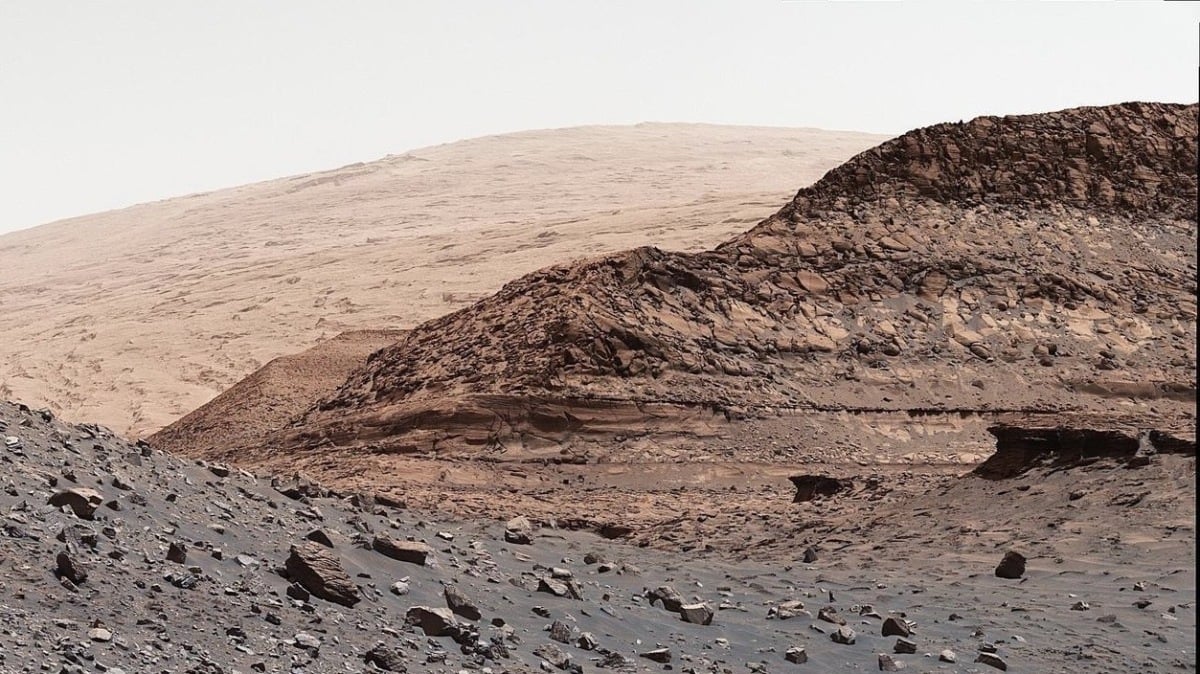A NASA rover taking rock samples on Mars has uncovered a plentiful mineral that was invisible to orbiters studying the Red Planet from space.
Scientists say the discovery of siderite, a type of iron carbonate, could be crucial evidence to support the theory that Mars once had a thick carbon dioxide-rich atmosphere, allowing a warm enough environment to support oceans, lakes, and streams.
Curiosity, a car-sized lab on six wheels, performed a chemical analysis of four rock samples drilled at different elevations of Mount Sharp, a mountain it has been exploring within Gale Crater. Three of the samples showed considerable amounts of siderite. Another sample, which had no significant traces of siderite, contained other iron-rich minerals that can form as siderite breaks down.
This iron carbonate mineral is known to form on Earth under specific chemical conditions involving water, iron, and carbon dioxide. The study, published in the journal Science, suggests more carbon is stored in the Martian crust than previously thought. And if similar carbonates exist in other sulfate-rich regions, they could represent a hidden trove of Mars’ ancient atmosphere.
“The discovery of abundant siderite in Gale Crater represents both a surprising and important breakthrough in our understanding of the geologic and atmospheric evolution of Mars,” said Benjamin Tutolo, lead author of the paper, in a statement.
These scientists think alien life best explains what Webb just found

NASA’s Curiosity rover snaps a selfie image on lower Mount Sharp in Gale crater in August 2015.
Credit: NASA / JPL-Caltech / MSSS
The results contribute to mounting evidence that ancient Mars had the right chemical and environmental conditions not only to have liquid water but also to trap and cycle carbon in the air — factors that may speak to the planet’s past habitability.
Mashable Light Speed
Scientists have had a long-standing theory that Mars used to have surface water. But for that to happen, the planet also would have needed to be warmer, with higher air pressure. That has led them to believe that though Mars’ atmosphere is extremely thin today, it must have been thick and carbon dioxide-rich in the past.
Volcanoes could have released large amounts of carbon dioxide into the air. Over time, some of that gas escaped into space, but enough probably stayed to support lakes and rivers.
Over the past three decades, researchers have found lots of evidence that water flowed on ancient Mars. But up until now there’s been a missing puzzle piece for the atmosphere within the rock record: Carbon dioxide in the air and water almost certainly would have reacted with rocks to create various carbonate minerals, so where are they?

At a Martian site nicknamed Ubajara, NASA’s Curiosity rover discovers siderite, an iron carbonate mineral that might solve a mystery about how the planet lost its thicker atmosphere.
Credit: NASA / JPL-Caltech / MSSS
After drilling less than 2 inches below the surface, Curiosity used its CheMin instrument to conduct X-ray diffraction analyses of rock and soil samples, according to the new paper. The presence of siderite in them means the rocks likely formed in calm water like lakebeds, not volcanoes or lava. On Earth, siderate tends to form in shallow lakes and swamps.
Curiosity also detected sulfates, minerals that form when water evaporates. Geologists glean clues about a planet’s past from the order in which minerals formed. That siderite came first in the sequence suggests a gradual drying of ancient Martian lakes, leaving behind these other minerals. The sample that didn’t have siderite but had evidence of its breakdown materials supports the notion that Mars’ carbon cycle used to be active but became unbalanced over time.
“Drilling through the layered Martian surface is like going through a history book,” said Thomas Bristow, a NASA research scientist and co-author of the paper. “Just a few centimeters down gives us a good idea of the minerals that formed at or close to the surface around 3.5 billion years ago.”
If similar carbonates are found in other sulfate-rich layers across Mars, they could hold large amounts of carbon — perhaps equal to or even more than the carbon dioxide in Mars’ air today. Future observations could confirm these findings and illuminate how the planet changed as it lost its atmosphere.
